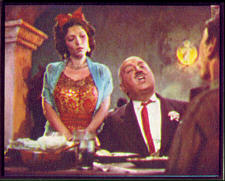 |
| |
 |  |  |
nature. But everybody on the sets had grown up in a black and white universe and did things in a black and white way. It was like a color-blind man trying to stage a Radio City spectacle. Actors and actresses put on their regular heavy makeup without realizing that the proper Technicolor makeup calls for rather less artificiality than the more extreme street makeups. And all the time the two-component process was struggling bravely but unsuccessfully to handle all the colors in the spectrum.
THEN -- like the cowboy bursting into the cabin just as the heroine has thrown the last flowerpot at the Mexican-came the three-color process to the rescue. There was |  LA CANTINA PANCHO: PANCHO'S BAR, AS VISUALIZED BY MR. JONES | |